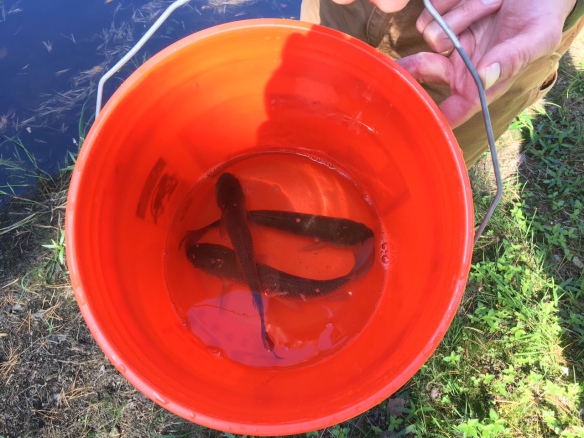About fifty years ago we had a pond dug at our poultry farm in Madison, Connecticut, to enhance the landscape and to provide water for the chickens in times of drought. When we converted our farm to a golf range some twenty years ago, and still rely on the pond to water the tee area when rainfall is insufficient.
The pond has not only been helpful, but has provided much enjoyment. Originally the State of Connecticut stocked it with trout. An amazing amount of wildlife found its way into our pond over the course of time. In addition to the trout, there were other fish whose eggs were carried to the area on the feet of ducks. Children loved to catch sunfish. We’ve had turtles and lots of frogs, even during the time when there was concern that the frog population was diminishing.
We swam, ice- skated and even paddled a canoe on the pond.
At a recent family gathering we noticed that our nephew’s pond was free of algae. He told us that he had carp in the pond, which feed on the algae and eat the mosquito larva as a bonus, and suggested that we contact the State of Connecticut Fish and Wildlife Service to see if our pond would be suitable for carp.
A representative from Fish and Wildlife assessed the pond and determined that three carp would be enough to eliminate the putrefaction of invasive algae, caused by a lack of oxygen and limited rainfall. He gave us a list of fish suppliers in our area, adding that we needed a permit from the State of Connecticut.
The fish, about $50 each, were delivered and tossed into the pond. They are only a few months old and about twelve to thirteen inches long, but they can grow to nearly four feet in length. The lifespan of this type of carp is between two to ten years. However we were advised to replace them halfway through their lifespan because larger fish have less of an appetite than the smaller ones, and would not be as effective. To control the population of the carp, electric shock is used to cause rearrangement of the chromosomes and render the fish neutered.
Apparently herons are apt to grab carp. We do see a heron at the pond occasionally and will cope with the predators as necessary.
The pond carp are related to Koi, seen in decorative landscape ponds and fish tanks, as well as pet goldfish. There are many edible varieties of carp that are also delicious, but I’m not planning to have a fish fry anytime soon.
After two days the carp seemed to have adjusted to their new habitat.
I’ll keep you posted!
,



This is so exciting. I cannot wait to ‘meet’ them. Any thoughts on names? You failed to mention eating lunch by the pond – always loved that. I also remember – not as fondly, shoveling the snow off the ice before we could skate…
Great post!
Thank you, Shimon. Yes, we’ve had our good times.
Wishing you a happy, healthy, peaceful, and prosperous New year.
Thank you, Madeline. Who could think of naming the fish when I couldn’t see them
as the came out of the bucket. The picture came out better than I expected. We’ll have to name the fish when you visit. Sometimes we were lucky; the neighbors shoveled the pond so they could skate
Got to admit; Lunch by the pond beats the executive dining room!
Sounds like you’ve lived your lives in a very pleasant environment. Best wishes.